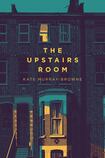
A story for our time: a scramble to find a house to fit a growing family, a mortgage scraped together, a property that divides a couple, a feeling of no way out once the deal has gone through. In her unsettling debut novel The Upstairs Room, Kate Murray-Browne captures the two-by-four situations that many people on the property ladder currently find themselves in. From the moment Eleanor and Richard buy a four-bed Victorian townhouse in east London with their two young daughters, an existential unease takes over the family.
This story for our time is also an age-old tale of course, the idea that a dwelling holds something dark within it that manifests itself in its inhabitants. Susan Hill's The Woman in Black, Shirley Jackson's The Haunting of Hill House and Edgar Allan Poe's The Fall of the House of Usher are classics of the form. While the fixer-upper in The Upstairs Room never achieves the personified eeriness of such haunted abodes, its hold over its inhabitants is sensitively related and gripping.
Reluctant to buy the house, mother Eleanor is the worst-affected, feeling a sense of malaise from the beginning: “Even the dust wasn’t normal – it was browner and denser than ordinary dust. It made the light grey fluffy kind seem clean.” The discovery of a room on the top floor that belonged to a troubled young girl of the previous owners does little to quell her nerves.
The writing is literally on the wall: drawings of birds and frenzied scribbles cover the room. Although Eleanor’s rational, and at times intensely irritating, husband agrees it’s strange, he’s more interested in what colour they might choose to paint over it. Murray-Browne’s arch perspective on the interiors-obsessed stereotype is clever in its gender reversal. Richard is a Cambridge graduate who has yet to find a career path, a man “floored by the terror of not making any impact on the world”. He pours his energy into the house instead, rarely achieving anything beyond aspirational blather.
Killer migraines
Eleanor meanwhile gets sick – killer migraines, bouts of vomiting, a troubled relationship with her once-amiable toddler Rosie. Household items are misplaced: a spoon in the oven, scissors in the bread bin, a grotesque salmon skin in her tea. Eleanor finds secret scribbles on the walls downstairs, “the scrawls like vermin”. At the front gate, a line of carefully placed pebbles reappears no matter how many times she discards them.
It’s enough to make you think Eleanor is going mad, except that Murray-Browne introduces another perspective into the mix in the form of a lodger. Zoe is in her mid-20s, a creative type trying to find herself after the end of a long-term relationship. While readers lose the ambiguity over Eleanor’s mental state, as Zoe is also party to strange events, we gain plenty in character insight as the housemates scrutinise each other.
From London, Murray-Browne studied English at Cambridge and worked in publishing for 10 years. In her realistic and multifaceted fiction centred on precarious relationships, she has more in common with writers like David Nicholls and Laura Barnett than the ghost story genre that frames her narrative. The story of Emily, the distressed daughter of the former inhabitants, is intriguing and drives momentum but it is underdeveloped and never truly resolved. The Rosie subplot is similarly creepy but tapers off.
Interior lives
What makes The Upstairs Room so compelling are the characters' interior lives. For Eleanor, the house is a metaphor for a grander, less understood pain: "It became clear that resting every time she felt sick was not an option: she couldn't stop participating in life altogether." Murray-Browne delves into Richard and Eleanor's past to highlight what else might be driving the illness. Sometimes the pain is "a thick black liquid crashing at the sides of her head as she threw up in the wastepaper basket". Time spent away from house reduces it to "a thin, faint pain covering her head like a cap".
Humour comes through the hardship, particularly with Eleanor’s struggles to deal with her children: “Rosie had been wilful and aggressive all morning – ice cream now; do real drinking, not pretend drinking; not that cup; draw a curly wurly; that’s not a curly wurly.” A similarly wry tone enlivens Zoe’s story of trying to find her feet when everyone around her seems to be settling down: “There was always so much to say, and none of it interesting: chains collapsed, people were inefficient or unscrupulous, things got gazumped and gazundered.”
Like all good haunted house novels, the real demons are not to be found in the creaks and crevices, or even in the macabre imagery of maggots and dead birds. The premise of The Upstairs Room, as Eleanor belatedly notes, is much scarier than that: "The thing that's wrong – you think it's coming from us?"













